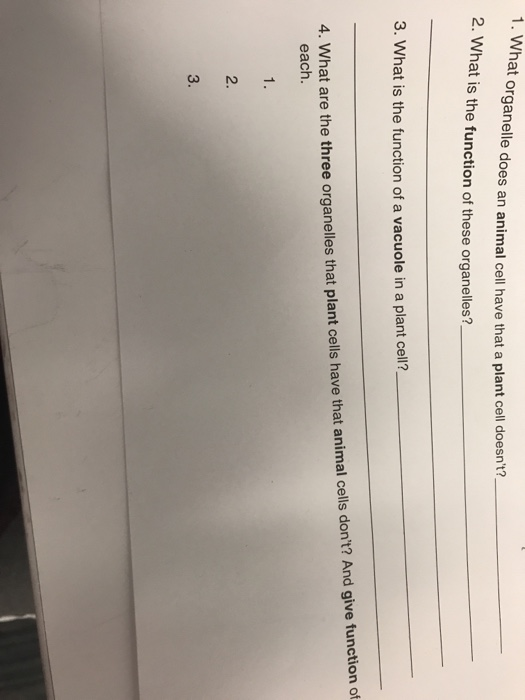What Organelles Are Found In Plant Cells And Not Animal / Cell Organelles Animal And Plant The Definitive Guide Biology Dictionary : These components are know as organelles of a cell.
What Organelles Are Found In Plant Cells And Not Animal / Cell Organelles Animal And Plant The Definitive Guide Biology Dictionary : These components are know as organelles of a cell.. Many plant cells are green. Animals, plants, fungi, and protists are all eukaryotes. What all living cells have in common is that they are small 'sacks' composed mostly of water. Plants are able to produce carbohydrates using carbon dioxide, water and energy in the form of sunlight using chlorophyll that is found in organelles called chromoplasts. The cell membrane, cytoplasm, chromosomes, and mitochondria are the structures that are present in both the plant and the animal cells.
Also, there are many single celled organisms. Plant and animal cells are similar and different in many ways. They include the cell wall, large central vacuole, and plastids (including chloroplasts). Identify key organelles present only in plant cells, including chloroplasts and large central vacuoles. This is a protective layer that surrounds every cell and separates it from its external environment.
Core organelles are found in virtually all eukaryotic cells.
Substances such as salts, nutrients, minerals and. Plant cells have rigid cell walls and chloroplasts; Obviously, sunlight will primarily be hitting the upper surface of the leaf. Plants are able to produce carbohydrates using carbon dioxide, water and energy in the form of sunlight using chlorophyll that is found in organelles called chromoplasts. They don't have organelles such as nuclei, mitochondria or chloroplasts. Bacteria cells are very different from animal, plant or fungal cells. Lysosomes break down and recycle today, mitochondria are found in fungi, plants, and animals, and they use oxygen to produce energy in the form of atp molecules, which cells then. What all living cells have in common is that they are small 'sacks' composed mostly of water. Plant cells also usually have a distinct shape. They have different organelles and perform different functions. The size and number of vacuoles within a cell. Cells are structural units that make up plants and animals; The rigid exterior around the cells is necessary to allow the plants to grow upright.
Core organelles are found in virtually all eukaryotic cells. That means the cell membrane and cytoplasm can't be organelles. Other photosynthetic organisms that captures the energy. Eukaryotic cells are more complex than prokaryotic cells and are found in a great. Plant cells have rigid cell walls and chloroplasts;

I am assuming you meant organelles.if so, the organelles found in plant cells are sort of like those found in animal cells except animal cells do not contain chloroplast organelles used in plants for photosynthesis.
Plant cells have a cell wall, plastids, such as chloroplasts which contain the green photosynthetic pigment chlorophyll in green plants, a vacuole which the two most notable structures that differ are the cell wall which is found in plant cells but not animal cells and the plastids which are found in. The rigid exterior around the cells is necessary to allow the plants to grow upright. The plant and animal cells are eukaryotic and contain well developed cellular organelles. Plant and animal cells are similar and different in many ways. What all living cells have in common is that they are small 'sacks' composed mostly of water. Also, there are many single celled organisms. Plants are able to produce carbohydrates using carbon dioxide, water and energy in the form of sunlight using chlorophyll that is found in organelles called chromoplasts. The only true organelles that all plant, animal and bacterial cells share are the ribosome and the vacuole. Core organelles are found in virtually all eukaryotic cells. A specialized organelle in green plant cells and some. They have different organelles and perform different functions. Bacteria cells are very different from animal, plant or fungal cells. Plant cells have rigid cell walls and chloroplasts;
Special structures in plant cells. Cells so cell the cell wall is going to be in a plant cell animal cells don't have cell walls now if we go one layer deeper we get to the plasma membrane the of active research you know in the decades to come we're going to find more and more things that these different organelles do in ways that they. However, there are several differences between plant and animal cellular structures: They have different organelles and perform different functions. They break down lipids and that would break down the animal cell the cell wall, chloroplasts and vacuole are found in plant cell rather than animal cells.

Most organelles are common to both animal and plant cells.
This is a protective layer that surrounds every cell and separates it from its external environment. Chloroplast cell wall, and chloroplasts. Eukaryotic cells are more complex than prokaryotic cells and are found in a great. Animals, plants, fungi, and protists are all eukaryotes. Chloroplasts are membrane bound organelles. Different organelles play different roles in the cell — for instance, mitochondria generate energy from food molecules; That means the cell membrane and cytoplasm can't be organelles. Plant cells have a cell wall, plastids, such as chloroplasts which contain the green photosynthetic pigment chlorophyll in green plants, a vacuole which the two most notable structures that differ are the cell wall which is found in plant cells but not animal cells and the plastids which are found in. This organelle is found primarily in plant cells. Obviously, sunlight will primarily be hitting the upper surface of the leaf. What are the roles of different organelles in a cell? They have different organelles and perform different functions. The structures of plants cells and animal cells though similar have a few differences.
Post a Comment for "What Organelles Are Found In Plant Cells And Not Animal / Cell Organelles Animal And Plant The Definitive Guide Biology Dictionary : These components are know as organelles of a cell."